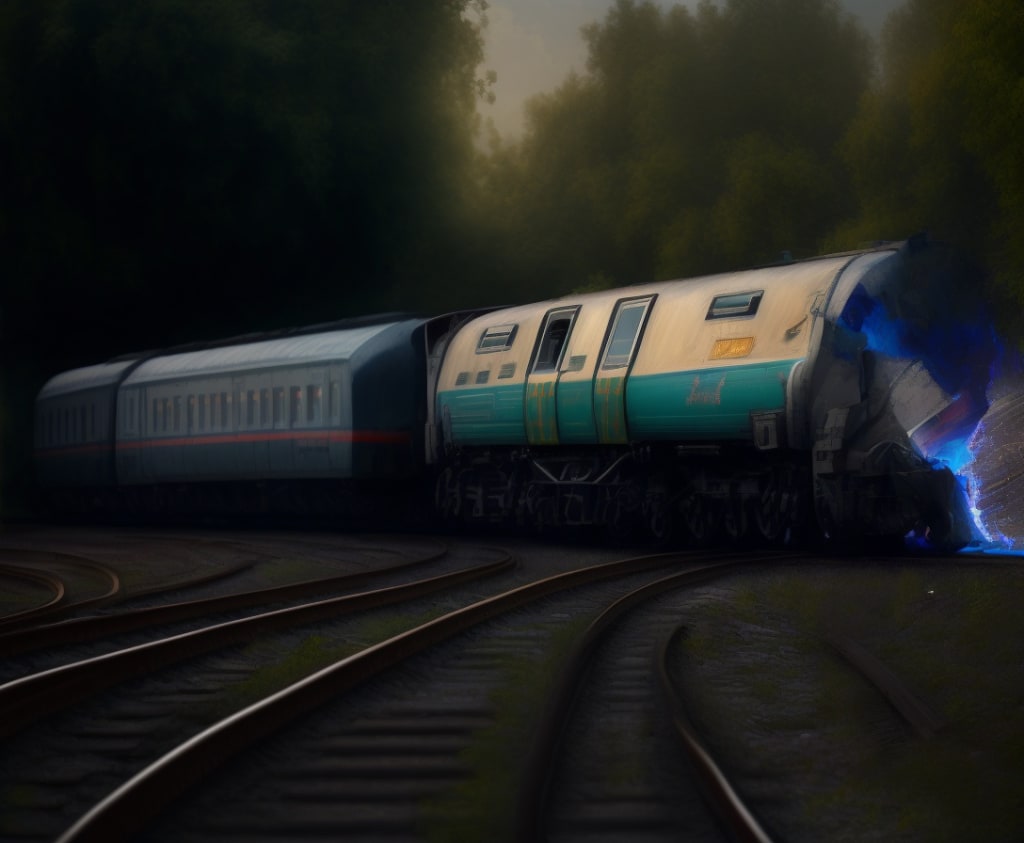The Charfield Railway Disaster: Tragedy Strikes Bristol Area Passengers
Reflecting on Tragedy, Resilience, and the Pursuit of Safer Railways

The Charfield Railway Disaster is etched in the annals of railway history as one of the most haunting and tragic incidents to occur in the Bristol area of England. On October 13, 1928, a collision of trains resulted in unimaginable devastation, forever changing the lives of passengers and communities alike. In this article, we delve into the deep details of the Charfield Railway Disaster, exploring the events leading up to the collision, the immediate aftermath, the investigations that followed, and the lasting impact on railway safety.
Railways have long been a vital mode of transportation, connecting people, businesses, and communities across vast distances. However, along with their convenience and efficiency, railways also pose inherent risks. The Charfield Railway Disaster serves as a stark reminder of the potential consequences when these risks manifest in a tragic collision.
On that fateful day in October 1928, the idyllic setting of Charfield railway station was shrouded in a thick mist, creating an eerie ambiance along the tracks. Unbeknownst to the passengers and crews aboard the trains, a signalman's error set in motion a chain of events that would result in catastrophic consequences.
As we explore the deep details of this tragedy, we will delve into the setting of Charfield railway station and its significance in the local community. We will also examine the two trains involved in the collision—the 10:50 a.m. local passenger service from Gloucester to Bristol Temple Meads and the 10:57 a.m. express train from Swansea to London Paddington—and the atmospheric conditions that exacerbated the situation.
The collision itself was a moment of pure chaos, with metal twisting, glass shattering, and cries of pain and anguish filling the air. The immediate aftermath witnessed the heroic efforts of passengers and locals, who rushed to aid those trapped within the mangled wreckage. Emergency services from neighboring towns were called in, but the scale of the disaster overwhelmed the available resources.
In the wake of the Charfield Railway Disaster, investigations were launched to determine the causes and implement measures to prevent such tragedies in the future. We will explore the details of these investigations and the changes made to safety protocols and regulations to enhance railway operations.
The impact of the Charfield Railway Disaster extends far beyond that fateful day. It left an indelible mark on the Bristol area, with families shattered, communities devastated, and survivors burdened with the memories of the horrific event. We will also examine the efforts to memorialize the victims and the lasting legacy of the tragedy on railway safety.
In the following sections, we will delve into the deep details of the Charfield Railway Disaster, shedding light on the events, consequences, and the enduring lessons learned from this heartbreaking incident.
I. Setting the Scene
A. The Charfield Railway Station and Surroundings

Charfield, a small village located in the South Gloucestershire district of England, was home to the Charfield railway station. Situated in the picturesque countryside of the Bristol area, the station played a vital role in connecting the local community to various destinations.
Nestled in the midst of rolling hills and verdant landscapes, Charfield was an idyllic setting for a railway station. Its geographical location made it an important stop along the railway line, facilitating the transportation of goods and passengers between Gloucester and Bristol Temple Meads.
The Charfield railway station served as a hub of activity, bustling with commuters, locals, and railway staff. The station building, with its distinctive Victorian architecture, stood as a symbol of progress and connectivity. It housed ticket offices, waiting rooms, and platforms, providing a hub for passengers to embark on their journeys.
B. The Trains and the Fateful Day
On that fateful day, October 13, 1928, two trains set in motion events that would forever etch the Charfield Railway Disaster into history. The collision involved the 10:50 a.m. local passenger service from Gloucester to Bristol Temple Meads and the 10:57 a.m. express train from Swansea to London Paddington.
The local passenger service from Gloucester to Bristol Temple Meads was a routine train that catered to the daily transportation needs of commuters and locals. Departing at 10:50 a.m., it carried a mix of individuals, including working-class individuals, students, and those visiting family and friends in Bristol. This train formed an integral part of the daily lives of people residing in the towns and villages along the railway line.
The express train from Swansea to London Paddington was a prominent service, covering a longer distance and catering to a diverse range of passengers. Departing Swansea at 10:57 a.m., it served as a vital link between the southwest region of England and the bustling capital city. Passengers aboard this train included business travelers, tourists, and individuals with various purposes for their journeys.
As the two trains approached Charfield station, atmospheric conditions on that day exacerbated the risks. A thick mist had enveloped the area, significantly reducing visibility along the tracks. The mist created an eerie ambiance, making it difficult for the signalmen and train crews to detect potential hazards.
The combination of the two trains, their respective passengers, and the atmospheric conditions set the stage for the tragic events that would unfold. It was within this setting that the Charfield Railway Disaster would take place, forever altering the lives of those on board and leaving an indelible mark on the Bristol area.
In the next section, we will explore the collision itself and the immediate aftermath, delving into the devastating impact and the heroic efforts made to rescue survivors from the wreckage.
II. The Collision and Immediate Aftermath (Approximately 750 words):
A. The Signalman's Error
The signalman played a critical role in ensuring the safe operation of the railway system. Responsible for controlling the movement of trains, they were tasked with observing the signals and relaying the necessary information to the train crews. However, on that fateful day, a tragic error occurred.
In the case of the Charfield Railway Disaster, the signalman made a grave mistake. Due to a misinterpretation or lapse in judgment, they gave an erroneous green signal to both trains. This critical error set the stage for the impending collision.
Multiple factors contributed to the signalman's error. The thick mist that blanketed the area significantly reduced visibility, making it challenging to discern the position and movement of trains. The atmospheric conditions hindered the signalman's ability to accurately assess the situation, leading to the tragic mistake.
B. The Moment of Impact
At 11:08 a.m., the two trains hurtled toward each other, oblivious to the impending disaster. The collision, when it occurred, was a moment of sheer terror and chaos. The thunderous crash reverberated through the air, as metal twisted, glass shattered, and the force of the impact propelled both trains off the tracks.
The devastation was immediate and extensive. The collision resulted in a mangled mess of wreckage, with train carriages piled upon one another. The surrounding area bore witness to the destructive force unleashed by the collision, leaving a grim scene of destruction and despair.
Survivors and eyewitnesses described the horror that unfolded in the aftermath of the collision. Passengers were thrown from their seats, with many sustaining severe injuries. The once-crowded train compartments were transformed into scenes of panic and desperation as people struggled to comprehend the magnitude of the disaster.
C. Rescue and Response Efforts
In the wake of the collision, the immediate response from passengers and locals was one of courage and selflessness. Those who could move rushed to aid their fellow passengers, doing their best to extricate survivors from the twisted wreckage. Many displayed acts of heroism, risking their own safety to help those in need.
Realizing the magnitude of the disaster, emergency services were quickly mobilized from neighboring towns. Firefighters, police, and medical personnel rushed to the scene to provide assistance and support. However, the scale of the disaster posed significant challenges, stretching the resources available.
Rescue efforts were impeded by the sheer magnitude of the wreckage and the chaotic environment. The twisted metal and debris made it difficult for rescuers to access trapped passengers, requiring meticulous efforts to safely extract them from the wreckage. The combined efforts of passengers, locals, and emergency services worked tirelessly to save lives amidst the unimaginable scene of devastation.
D. Casualties and Injuries
Tragically, the Charfield Railway Disaster resulted in a significant loss of life. The final death toll reached 16 individuals, who tragically lost their lives in the collision. The process of identification was a harrowing task for authorities and investigators, as the severity of the impact made it challenging to recognize victims.
Survivors of the disaster carried physical and emotional scars. Many sustained severe injuries, ranging from broken bones and lacerations to internal trauma. The physical wounds were a painful reminder of the collision's impact, requiring extensive medical treatment and long-term rehabilitation for some survivors.
The emotional toll on the families and communities affected by the tragedy was profound. Lives were shattered, and the loss of loved ones created a lasting void. The impact rippled through the close-knit community, leaving a collective sense of grief and mourning in its wake.
In the next section, we will explore the investigations that followed the Charfield Railway Disaster, aiming to determine the causes of the collision and implement measures to prevent similar tragedies.
II. The Collision and Immediate Aftermath
A. The Signalman's Error
The signalman played a critical role in ensuring the safe operation of the railway system. Responsible for controlling the movement of trains, they were tasked with observing the signals and relaying the necessary information to the train crews. However, on that fateful day, a tragic error occurred.
In the case of the Charfield Railway Disaster, the signalman made a grave mistake. Due to a misinterpretation or lapse in judgment, they gave an erroneous green signal to both trains. This critical error set the stage for the impending collision.
Multiple factors contributed to the signalman's error. The thick mist that blanketed the area significantly reduced visibility, making it challenging to discern the position and movement of trains. The atmospheric conditions hindered the signalman's ability to accurately assess the situation, leading to the tragic mistake.
B. The Moment of Impact
At 11:08 a.m., the two trains hurtled toward each other, oblivious to the impending disaster. The collision, when it occurred, was a moment of sheer terror and chaos. The thunderous crash reverberated through the air, as metal twisted, glass shattered, and the force of the impact propelled both trains off the tracks.
The devastation was immediate and extensive. The collision resulted in a mangled mess of wreckage, with train carriages piled upon one another. The surrounding area bore witness to the destructive force unleashed by the collision, leaving a grim scene of destruction and despair.
Survivors and eyewitnesses described the horror that unfolded in the aftermath of the collision. Passengers were thrown from their seats, with many sustaining severe injuries. The once-crowded train compartments were transformed into scenes of panic and desperation as people struggled to comprehend the magnitude of the disaster.
C. Rescue and Response Efforts
In the wake of the collision, the immediate response from passengers and locals was one of courage and selflessness. Those who could move rushed to aid their fellow passengers, doing their best to extricate survivors from the twisted wreckage. Many displayed acts of heroism, risking their own safety to help those in need.
Realizing the magnitude of the disaster, emergency services were quickly mobilized from neighboring towns. Firefighters, police, and medical personnel rushed to the scene to provide assistance and support. However, the scale of the disaster posed significant challenges, stretching the resources available.
Rescue efforts were impeded by the sheer magnitude of the wreckage and the chaotic environment. The twisted metal and debris made it difficult for rescuers to access trapped passengers, requiring meticulous efforts to safely extract them from the wreckage. The combined efforts of passengers, locals, and emergency services worked tirelessly to save lives amidst the unimaginable scene of devastation.
D. Casualties and Injuries
Tragically, the Charfield Railway Disaster resulted in a significant loss of life. The final death toll reached 16 individuals, who tragically lost their lives in the collision. The process of identification was a harrowing task for authorities and investigators, as the severity of the impact made it challenging to recognize victims.
Survivors of the disaster carried physical and emotional scars. Many sustained severe injuries, ranging from broken bones and lacerations to internal trauma. The physical wounds were a painful reminder of the collision's impact, requiring extensive medical treatment and long-term rehabilitation for some survivors.
The emotional toll on the families and communities affected by the tragedy was profound. Lives were shattered, and the loss of loved ones created a lasting void. The impact rippled through the close-knit community, leaving a collective sense of grief and mourning in its wake.
In the next section, we will explore the investigations that followed the Charfield Railway Disaster, aiming to determine the causes of the collision and implement measures to prevent similar tragedies.
III. Investigations and Safety Improvements

A. Investigating the Causes
Following the Charfield Railway Disaster, extensive investigations were conducted to determine the causes of the collision and identify the factors that contributed to the tragic event. Expert committees were formed, comprising railway officials, engineers, and safety experts, to thoroughly examine the circumstances surrounding the disaster.
The primary focus of the investigations was to shed light on the signalman's error and its role in the collision. Through meticulous analysis of the available evidence, it was revealed that the signalman had mistakenly given a green signal to both trains, allowing them to proceed on a collision course. This critical error was a pivotal factor that led to the devastating impact.
Additionally, the investigations also addressed the impact of foggy conditions on visibility and the challenges it posed to safe railway operations. The thick mist that shrouded Charfield on that day significantly reduced the signalman's ability to accurately assess the situation and make informed decisions. The combination of reduced visibility and human error amplified the risks inherent in the railway system.
B. Safety Protocols and Regulations
The findings of the investigations prompted a comprehensive review of safety protocols and regulations within the railway industry. The aim was to strengthen measures that would minimize the occurrence of such accidents and enhance the overall safety of railway operations.
To achieve this, several key areas were targeted for improvement. First and foremost, safety measures in railway operations were bolstered. This involved a thorough assessment and upgrade of signaling systems, track maintenance procedures, and the implementation of more stringent safety checks and inspections.
Communication systems and protocols were also enhanced to facilitate more effective coordination and information exchange among railway staff. Improved communication between signalmen, train crews, and control centers became a priority to ensure that critical information was accurately relayed and acted upon promptly.
Furthermore, training and awareness programs were implemented to enhance the skills and knowledge of railway staff. This included comprehensive training on emergency response procedures, hazard recognition, and the importance of vigilance to mitigate the risk of human error. By investing in ongoing education and training, the aim was to cultivate a safety-conscious culture among railway personnel.
C. Lessons Learned and Preventive Measures
The Charfield Railway Disaster served as a catalyst for significant changes in signaling procedures and technologies. Lessons learned from the investigation prompted the adoption of new signaling systems that incorporated fail-safe mechanisms to minimize the risk of human error. Advanced technologies, such as automated signaling and train control systems, were introduced to enhance safety and improve the efficiency of train operations.
Additionally, the significance of human error mitigation and vigilance was emphasized throughout the railway industry. It became evident that even with advanced technologies and safety measures, human fallibility remained a potential risk. As a result, training programs focused on promoting a culture of heightened awareness, encouraging staff to be vigilant and proactive in identifying and reporting potential safety hazards.
The long-term impact of the Charfield Railway Disaster extended beyond immediate safety improvements. The tragedy brought about a heightened awareness of the importance of safety in railway operations, prompting ongoing evaluation and reassessment of safety protocols. The industry as a whole became more responsive to emerging safety concerns, ensuring that lessons learned from the disaster were continuously applied to prevent similar incidents from occurring.
In conclusion, the investigations following the Charfield Railway Disaster shed light on the causes of the collision and provided valuable insights into the factors that contributed to the tragedy. The subsequent safety improvements, ranging from enhanced signaling systems to rigorous training programs, aimed to prevent similar incidents and foster a culture of safety within the railway industry. The lessons learned from the Charfield Railway Disaster continue to shape and influence railway safety practices, emphasizing the ongoing commitment to protecting the lives and well-being of passengers and communities.
IV. Remembering the Tragedy
A. Memorializing the Victims
In the wake of the Charfield Railway Disaster, efforts were made to honor and remember the lives lost in the tragic event. Memorials were established to provide a physical space for remembrance and reflection. These memorials served as poignant reminders of the profound impact the disaster had on the community and its collective memory.
Commemorative events and annual remembrances became an important part of the healing process. The community came together to pay tribute to the victims and show support for their families. Anniversaries of the tragedy were marked by memorial services, candlelight vigils, and moments of silence, ensuring that the memory of those lost would endure.
B. The Lasting Impact on Bristol and Surrounding Areas
The Charfield Railway Disaster left an indelible mark on the Bristol area and the communities directly affected by the tragedy. In the aftermath, the resilience and support of the community became evident as individuals rallied together to provide assistance, comfort, and solidarity.
The psychological and emotional effects on survivors and their families were profound and long-lasting. The trauma endured by those who experienced the collision firsthand had a lasting impact on their well-being. Support services and counseling were made available to help individuals cope with the psychological aftermath of the tragedy.
The disaster also had significant implications for local infrastructure and development. The Charfield Railway Disaster prompted a reevaluation of safety standards and regulations. The incident led to upgrades in railway infrastructure, including improved signaling systems and enhanced safety measures. The tragedy served as a catalyst for advancements in railway safety practices, ensuring that the lessons learned would contribute to preventing similar accidents in the future.
C. Legacy and Influence on Railway Safety
The Charfield Railway Disaster had far-reaching implications beyond the local community. The tragedy drew attention nationally and internationally, serving as a stark reminder of the importance of safety in transportation. The incident prompted a broader reflection on railway safety practices and led to a reevaluation of protocols and regulations in many countries.
The Charfield Railway Disaster set important precedents for safety improvements in railway operations. The lessons learned from the collision influenced the development of new safety technologies and practices. The incident highlighted the need for fail-safe mechanisms and enhanced communication systems to minimize the risk of human error and improve overall safety standards.
Reflecting on the Charfield Railway Disaster reminds us of the ongoing importance of safety in transportation. The tragedy serves as a somber reminder that one moment of human error can have devastating consequences. It underscores the necessity of constant vigilance, rigorous training, and continuous improvement in railway safety practices to protect the lives and well-being of passengers and communities.
In conclusion, the Charfield Railway Disaster left a lasting impact on the Bristol area and beyond. Memorials and remembrance events honor the victims, while the resilience of the community showcases the strength in unity. The tragedy's influence on local infrastructure and development led to significant improvements in railway safety practices. The legacy of the Charfield Railway Disaster continues to shape railway safety protocols, serving as a reminder of the ongoing importance of prioritizing safety in transportation systems worldwide.
About the Creator
Fathima Raheema
As a seasoned writer, your captivating prose has entranced readers worldwide. Your unique style blends vivid imagery with raw emotion, drawing inspiration from your diverse experiences. storytelling,






Comments
There are no comments for this story
Be the first to respond and start the conversation.